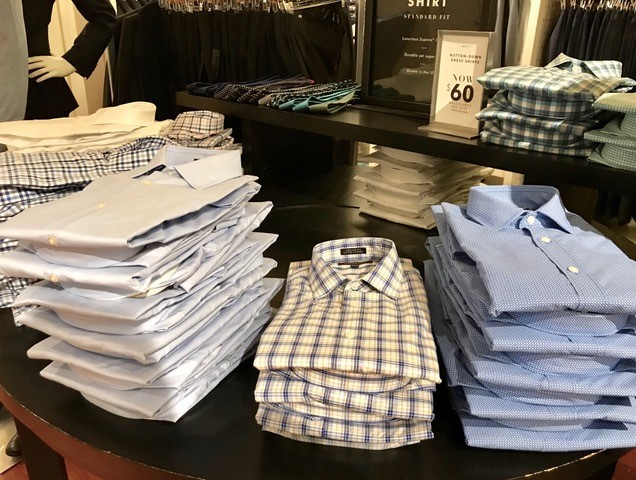Spring is here!
That means it’s time for the annual clothing pilgrimage. The winter gear moves down into the giant Tupperware containers in the basement crawlspace, and the spring and summer collection is liberated upstairs to the bedroom dresser. There’s probably a better way to set up the dusty crawlspace to reduce the head bonking and sneezing, but let’s save that for next year. Actually, that was the plan last year as well.
Everything gets laid out on the bed for inspection. But something happened to your spring togs over the winter. A small moth hole here, a few pieces starting to push fashion boundaries there. Oh, and those pants are looking a bit frayed along the bottom. And it seems they, ahem, shrunk some over the winter. Somehow.
Time to refresh the wardrobe.
Where better to find some new gear than the mall? The trip offers an invigorating traffic jam or two, a rousing parking space hunt, and then the blanching effect of 3 hours of fluorescent lights and some denatured music. Browsing the clothing racks, it looks like the good stuff is all at full price and the sale rack holds only the most garish patterns and XS sizing. Out comes the credit card to load up on the good stuff anyway, because, well, it’s the good stuff! Never mind the clothing costs. It’s worth it. But once the bills are all tallied, let’s just say you won’t be adding much to your TFSA for a while.
When did cashiers start taking email addresses?
Because I don’t want to give it to them. After all the scanning, beeping, and swiping was done, the clerk asks for your email address. Seriously? Who would fall for that one? The last thing any of us need is more junk email. By refusing, you dodged an additional daily onslaught. Nice work.
But what if those emails include something of value? Like real discounts of 30, 40, or 50%? And since they come from the store you just bought from, they are likely to be of interest to you. Maybe it’s worth giving the cashier your email address after all…
The problem, of course, is that clearing out email isn’t a fun task, and adding dozens more from retailers only adds to the misery. Many of the retailers will send out these offers daily, too. For those of us who don’t make daily clothing purchases, this is an issue.
Email rules to the rescue!
By setting up rules you can automatically divert these offer emails to dedicated mailbox folders. You can set up mailboxes for a specific retailer like Banana Republic, or for a category like clothing. And it works for more than just clothes! You can stash away bargain codes for travel, home repair bits, or whatever it is that you buy. The rules scan your inbox for relevant emails and then quietly whisk them away to their new home, ready for you on purchase day. Your inbox stays clear, and your discount codes are ready when you need them.
Here are the steps:
For Mac Apple Mail
- To set up mailboxes, go to mailbox/new mailbox, then pick its location and give it a name.
- For the rules, got to Mail/Preferences/Add Rule and unleash your inner programmer. It’s not so hard — just pick “From”, copy the email address from one of your offer emails, and tell it what folder to send it to.
- Repeat for all the different offers you’re getting, and you’re done! Your offers will be ready and waiting in their new homes.
For Microsoft Outlook
- To set up folders, go to New Items/Folder and give it a name.
- For the rules, go to Tools/Rules then click the “+” to add a rule that moves emails from specific senders. Pick “From”, copy the email address from one of your offer emails, and point it to the right folder.
- Repeat for all your different offers, and you’re done! Your offers will be ready and waiting in their new homes.
Not working right?
Recruit a tech-savvy friend or family member for some help or check your basement for a teenager. They know how to do these kinds of things.
Once the rules are in place, your inbox stays clear and the latest offers are at the ready to help you cut down on clothing costs. Of course, let’s not squander the savings on extra gear! Get them working for you by paying down some debt or increasing your savings.
For some great tips on how to do that, check out my book, Cashflow Cookbook. It’s jam-packed with recipes for savings that can save you millions.
Let me know how it goes!






